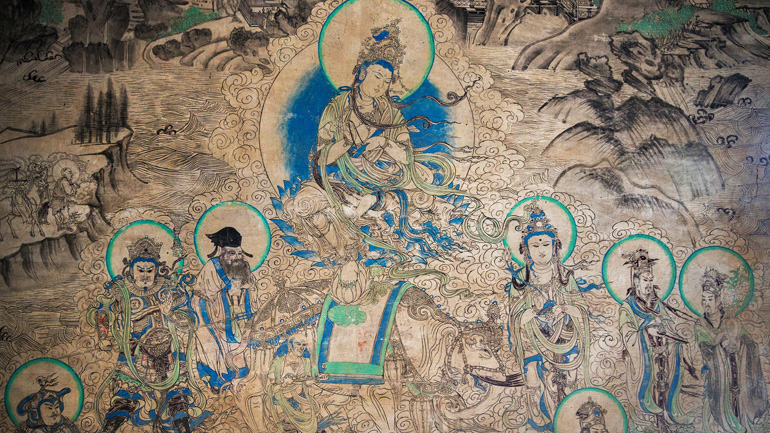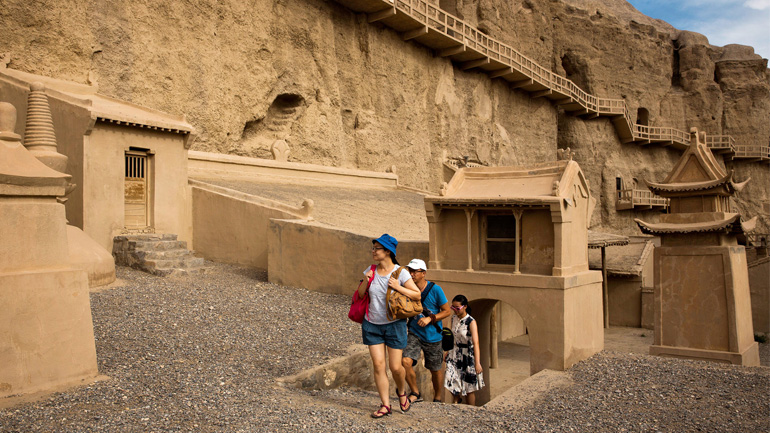The most splendid cave art was produced during the height of the early Tang dynasty from roughly 618 to 718, a period when the statues and mural paintings were the most sumptuous. In one tableau, which is rendered in greens, browns and beige, a wide-girthed, beautifully dressed Chinese emperor listens closely to a debate on Buddhist doctrine The artists, who usually painted with rabbit hairbrushes, achieved their rich colors by grinding and mixing mineral and organic pigments — red ocher, cinnabar, lapis lazuli — much as painters do today, according to Susan Whitfield, the director of the International Dunhuang Project at the British Library.
最灿烂的石窟艺术出现在唐初,大约在公元618年到718年之间,这期间创造的雕像和壁画最为瑰丽。在一个场景中,画师使用绿色、棕色和米色,描绘一位胖胖的、衣着精致的中国皇帝在认真倾听佛法辩论。大英图书馆(British Library)的国际敦煌项目(International Dunhuang Project)主任苏珊•惠特菲尔德(Susan Whitfield)说,这些画师通常使用兔豪毛笔,通过研磨和混合矿物,他们获得了层次丰富的色彩和有机颜料——赭红、朱砂、青金石——这与如今画家的做法相差不大。
After the Tang, there was a 70-year interlude of Tibetan rule, followed by a long line of local clans who commissioned life-size portraits of themselves. The Cao family, for example, loved their women, and had them painted on the cave walls with rouged cheeks, layers of splendid necklaces and voluminous gowns. Some of the caves used as chapels featured floor-to-ceiling paintings in lapis blue and earth reds that depict the life of the Buddha.
唐代以后,西藏对这里进行了70年的短暂统治,之后很长一段时间,当地的部族委托画师在这里为他们绘制真人大小的肖像。比如曹氏家族热爱自家的女性,就让画师把她们画在石窟的墙壁上,这些肖像脸颊上抹着胭脂,戴着华丽的项链,穿着繁琐的礼服。在一些被用作小佛堂的石窟中,画师用青金石蓝和土红色描绘了佛陀的一生,图案从地面延伸到窟顶。
In several caves, scenes show daily village life: figures bathing, wheat being winnowed and preparations for a wedding ceremony. Some caves are as large as a small ballroom with high coffered ceilings covered with fields of patterns that give the illusion of draped fabric in a desert tent. Others feature deep niches with life-size sculptures of Buddha and his disciples. Much of the painting is devoted to Buddha, but it was also easy to imagine from the mortal figures in the murals that during its heyday Dunhuang was alive with traders dealing in silk, furs, ceramics, gold and ivory.
在几个石窟中有日常乡村生活的场面:人们洗澡、扬谷、筹备婚礼。一些石窟的大小犹如小型宴会厅,格子天花板上布满了图案,看上去像是沙漠帐篷顶上的褶皱。另外一些石窟中深嵌着壁龛,里面是佛陀及其弟子真人大小的雕像。很多绘画都是关于佛陀的,但是从壁画描绘的世俗者形象中,你也很容易想象得到,在敦煌的鼎盛时期,买卖丝绸、皮草、陶瓷、黄金和象牙的商人让这里呈现出怎样的一派勃勃生机。
The size of some of the sculptures is startling. A 75-foot-tall Buddha stands bolt upright, carved from the rock face and covered in plaster, protected from the elements by the facade of the Nine-Story Temple. In a nearby cave, a 50-foot-long Buddha statue from the Tang dynasty lies on its side, tranquil in death, surrounded by paintings of anguished disciples.
一些雕像的尺寸十分惊人。一座笔直站立的佛像高75英尺,从岩壁上雕刻而出,覆以灰泥,并用"九层楼"为它遮风挡雨。在附近的一个石窟里,一座唐代的50英尺长涅槃佛像卧在一侧,周围画着悲痛的弟子。
On our second day — after being greeted by Ms. Gates's breakfast mantra, "Let's go to more caves" — we drove two hours in a minibus on a paved road to Yulin, a rock face that is also punctuated with caves. The desert and the distant snow-encrusted mountains along the route were a reminder of the terrain along the old Silk Road.
第二天,盖茨用他的早餐口头禅跟我们打招呼:"我们去看看更多的石窟"。之后我们乘坐一辆面包车,在一条铺面的路上行驶了两个小时,到达了榆林,那里的岩壁上也开凿了很多石窟。沿途看见沙漠和远处白雪点缀的山峰,不免想到古代丝绸之路的地形就是这样。

"This is one of the highlights," said Ms. Gates as we clambered with a young Chinese guide, Wang Yan, to Cave No. 3 at Yulin, a space measuring about 20 by 20 feet. Here the 10th-century artists painted with ink and brush in rich blues and greens the color of malachite. Landscapes with graceful waterfalls and willowy trees surrounded scores of Buddha's followers dressed in robes, their hair tightly knotted on top of their heads.
"这是亮点之一,"盖茨说,当时我们和年轻的中国导游王燕(音)爬上了榆林第3号石窟,里面的空间大约有20×20英尺。在这里,10世纪的艺术家们使用笔墨,画出了孔雀石那种层次丰富的蓝色和绿色壁画。佛陀的追随者们身着长袍,头发紧紧扎束在头顶,周围环绕着优美的瀑布和袅娜的树木。
One follower, Samantabhadra, her face a portrait of calm, sailed through the landscape on the back of an elephant whose feet were planted on lotus leaves. It was such fine line painting. Who were the artists?, we asked. The artists were almost always anonymous, and many were just paid with food, Ms. Gates said.
其中的一位追随者普贤菩萨面容平静,坐在脚踩荷叶的大象背上轻快地穿过一片山水。实在是精彩的线描绘画。我们询问是谁画的。盖茨表示,这些画家几乎都是无名的,其中很多人得到的唯一报酬是食物。
At Yulin, we ate a delicious farm-cooked lunch at a no-name rustic restaurant set beside the Yulin River, a fast flowing, narrow stream. The menu came from the fields: elm tree seeds coated in flour and steamed; stir-fried green beans; steamed pumpkin slices; and soup with freshly made noodles and veal.
我们在狭窄湍急的榆林河旁的一家无名乡村餐馆吃了一顿美味的农家午餐。菜单上的菜都来自田里:蒸榆钱、炒青豆、蒸南瓜片以及现做的面条和牛肉汤。
Back at the Mogao Caves, another local guide, Liu Qin, an art historian at the Dunhuang Academy, was eager to show us the spot where Warner ripped out the statue. In Cave No. 328, Mr. Liu showed us a Buddha set on a low platform surrounded by a half-dozen attendants. On the far left at an easy-to-reach height, one attendant is missing, a gap that destroys the symmetry of the tableau. A slightly raised gray plaster disc marks the place where Warner and his men removed the bodhisattva.
回到莫高窟,另一名当地导游——敦煌研究院的艺术历史学家刘勤(音)迫切地引领我们参观华尔纳劫走雕像的地方。在第328号石窟,刘勤向我们展示了坐在一个低矮的平台上、由六名侍者围绕的佛陀雕像。在最左边很容易触及的高度,少了一名侍者,这一缺口破坏了画面的对称性。一个略微高出一点的灰泥圆盘标记着华尔纳及其手下掠走的菩萨像所在的位置。
Mr. Liu was also anxious to take us to the place where Aurel Stein, a British historian, and Paul Pelliot, a French scholar, took thousands of books and manuscripts. Inside the entrance to Cave No. 17, Mr. Liu pointed to a small, nearly empty room where Stein found 7,000 manuscripts, including one of the world's oldest printed books, the Diamond Sutra, produced in 868. It is now at the British Library. Stein paid a local monk £130 for his booty. A little later, Pelliot took another substantial haul of scrolls for the Musée Guimet in Paris, and paid even less.
刘勤还热切地带我们参观了英国历史学家奥莱尔•斯坦因(Aurel Stein)和法国学者保罗•伯希和(Paul Pelliot)带走的数千份书籍及手稿所在的地方。在17号石窟入口处,刘勤指向一个很小而且几乎空荡荡的屋子,斯坦因在那里发现了7000份原稿,其中包括世界上历史最悠久的印刷书籍——公元868年印制的《金刚经》。《金刚经》现藏于大英图书馆(British Library)。斯坦因向一名当地僧侣支付了130英镑就带走了他所掠夺的物品。不久之后,伯希和以更低的价格带走了另一批书卷,送到巴黎的吉美艺术博物馆(Musée Guimet)。

In recent years, the Chinese authorities have said the treasures from Dunhuang now stashed abroad should be returned. That battle may be waged in the future. For the moment, the new director of the Dunhuang Academy, Wang Xudong, has a friendlier approach. Over lunch in his private dining room, Mr. Wang, who praised Ms. Gates's work, said he was intent on making Dunhuang not only a tourist attraction but also an international research center for scholars.
近些年来,中国当局曾表示,存放在海外的敦煌珍宝应该归还给中国。未来可能会上演争夺战。目前,敦煌研究院新任院长王旭东采取了一种比较友好的方式。在私人餐厅吃完午餐后,王旭东称赞了盖茨的工作,称他计划使敦煌不仅成为观光胜地,还要成为国际研究中心。
Unlike the Great Wall, a monument to China's strenuous efforts to keep outsiders at bay, ancient Dunhuang was inclusive, a fitting theme for the contemporary era of China's global reach.
长城是中国为抵御外来者开展的宏大工程的遗迹。与长城不同,古老的敦煌是兼收并蓄的,这是一个符合当代中国全球影响力的主题。
"Dunhuang is a broader story,'' he said. "It shows China's willingness to interact with other cultures."
"敦煌要更广阔,"他说。"显示了中国希望与其他文化互动的意愿。"



 闽公网安备 35020302035673号
闽公网安备 35020302035673号
0 responses on "Dunhuang caves: 1,000 years of Buddhist art in China (2)"